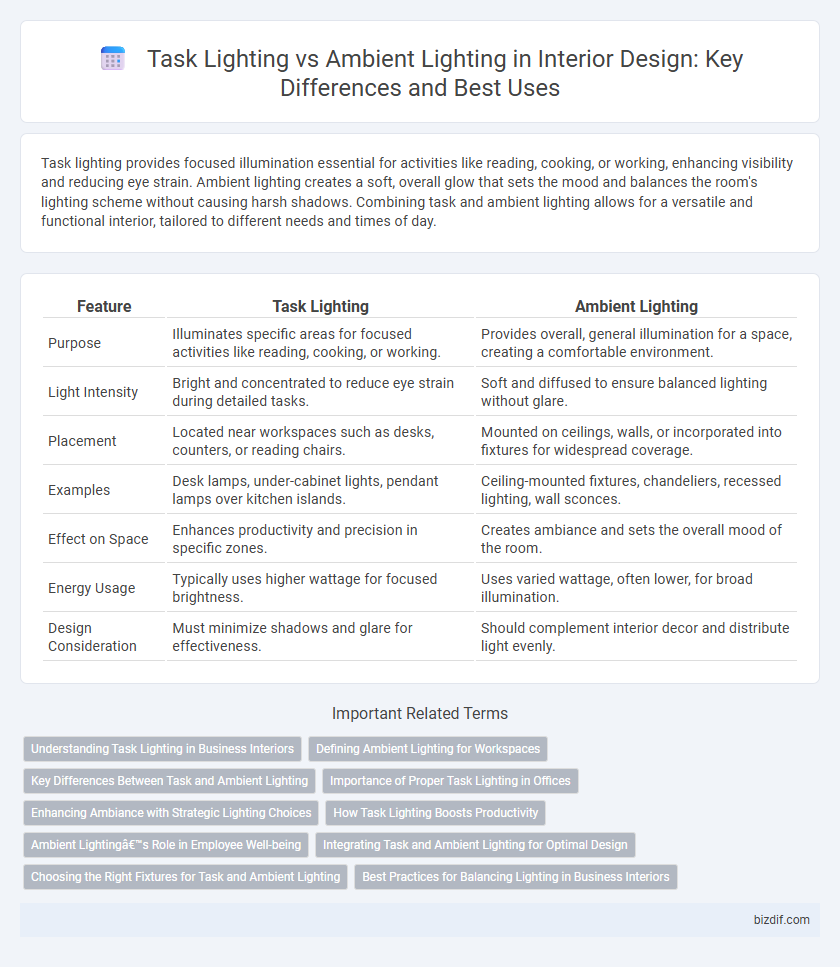Task lighting provides focused illumination essential for activities like reading, cooking, or working, enhancing visibility and reducing eye strain. Ambient lighting creates a soft, overall glow that sets the mood and balances the room's lighting scheme without causing harsh shadows. Combining task and ambient lighting allows for a versatile and functional interior, tailored to different needs and times of day.
Table of Comparison
| Feature | Task Lighting | Ambient Lighting |
|---|---|---|
| Purpose | Illuminates specific areas for focused activities like reading, cooking, or working. | Provides overall, general illumination for a space, creating a comfortable environment. |
| Light Intensity | Bright and concentrated to reduce eye strain during detailed tasks. | Soft and diffused to ensure balanced lighting without glare. |
| Placement | Located near workspaces such as desks, counters, or reading chairs. | Mounted on ceilings, walls, or incorporated into fixtures for widespread coverage. |
| Examples | Desk lamps, under-cabinet lights, pendant lamps over kitchen islands. | Ceiling-mounted fixtures, chandeliers, recessed lighting, wall sconces. |
| Effect on Space | Enhances productivity and precision in specific zones. | Creates ambiance and sets the overall mood of the room. |
| Energy Usage | Typically uses higher wattage for focused brightness. | Uses varied wattage, often lower, for broad illumination. |
| Design Consideration | Must minimize shadows and glare for effectiveness. | Should complement interior decor and distribute light evenly. |
Understanding Task Lighting in Business Interiors
Task lighting in business interiors provides focused, high-intensity illumination designed to enhance visibility for specific activities such as reading, writing, or computer work. Unlike ambient lighting, which offers general illumination for overall space, task lighting reduces eye strain and boosts productivity by illuminating work areas precisely. Incorporating adjustable LED fixtures and desk lamps tailored to workstation layouts optimizes ergonomic comfort and energy efficiency in professional environments.
Defining Ambient Lighting for Workspaces
Ambient lighting in workspaces provides uniform, overall illumination that reduces eye strain and creates a comfortable environment for various tasks. It establishes the foundational light level without causing glare or harsh shadows, enhancing focus and productivity throughout the workday. Unlike task lighting, ambient lighting ensures balanced brightness across the entire room, supporting a cohesive and visually comfortable workspace.
Key Differences Between Task and Ambient Lighting
Task lighting provides focused, intense illumination designed to enhance visibility for specific activities such as reading, cooking, or detailed work, ensuring precision and reducing eye strain. Ambient lighting offers a softer, general illumination that fills a room uniformly, creating an overall comfortable and inviting atmosphere. The key difference lies in their purpose and intensity: task lighting targets functionality with concentrated light, while ambient lighting prioritizes mood and space perception with diffused light.
Importance of Proper Task Lighting in Offices
Proper task lighting in offices enhances productivity by reducing eye strain and improving focus during detailed work such as reading, writing, or computer use. Unlike ambient lighting, which provides general illumination, task lighting offers targeted brightness that adapts to specific activities, ensuring clarity and comfort. Effective use of adjustable desk lamps, LED fixtures, and glare-free sources contributes to a healthier and more efficient workspace environment.
Enhancing Ambiance with Strategic Lighting Choices
Task lighting provides focused illumination for activities like reading or cooking, ensuring clarity and precision in specific areas. Ambient lighting creates a warm, inviting atmosphere by evenly distributing light throughout a room, enhancing the overall mood. Combining task and ambient lighting strategically elevates interior design, balancing functionality with aesthetic comfort.
How Task Lighting Boosts Productivity
Task lighting enhances productivity by providing focused illumination directly on work areas, reducing eye strain and increasing concentration. Unlike ambient lighting, which offers general brightness, task lighting supports precision and detail-oriented activities. Effective placement of LED desk lamps or under-cabinet lights optimizes workspace efficiency and minimizes distractions.
Ambient Lighting’s Role in Employee Well-being
Ambient lighting plays a crucial role in employee well-being by creating a comfortable and evenly illuminated workspace that reduces eye strain and fatigue. Proper ambient lighting helps regulate circadian rhythms, enhancing mood and productivity throughout the workday. Effective integration of ambient lighting supports mental clarity and overall health, making it an essential element in office interior design.
Integrating Task and Ambient Lighting for Optimal Design
Integrating task and ambient lighting enhances interior design by balancing functionality and atmosphere, ensuring well-lit workspaces alongside comfortable general illumination. Task lighting provides focused, high-intensity light for activities like reading or cooking, while ambient lighting delivers softer, evenly distributed light to create a welcoming environment. Combining these layers with dimmers and adjustable fixtures maximizes visual comfort and energy efficiency, optimizing both style and practicality in a space.
Choosing the Right Fixtures for Task and Ambient Lighting
Selecting the right fixtures for task lighting involves choosing focused, adjustable options such as desk lamps, under-cabinet lights, or pendant lights that provide concentrated illumination for specific activities. For ambient lighting, designers prioritize fixtures like ceiling-mounted lights, chandeliers, or wall sconces that offer diffuse, overall illumination to create a comfortable atmosphere. Balancing task and ambient lighting enhances functionality and mood while reducing eye strain and improving spatial perception in interior spaces.
Best Practices for Balancing Lighting in Business Interiors
Task lighting provides focused illumination for specific work areas, enhancing productivity and reducing eye strain in business interiors. Ambient lighting offers uniform, soft light that creates a comfortable and inviting atmosphere throughout the space. Combining adjustable task lights with strategically placed ambient fixtures ensures optimal visibility and aesthetic balance, promoting employee well-being and efficient workflow.
task lighting vs ambient lighting Infographic

 bizdif.com
bizdif.com